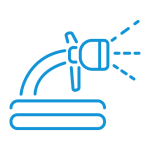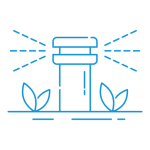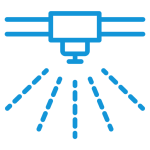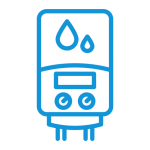Residential Customers
Essential information for residential water customers. Learn about cross-connection control, backflow prevention, and how you can help protect your home water system and the WSSC Water supply.
Essential information for residential water customers. Learn about cross-connection control, backflow prevention, and how you can help protect your home water system and the WSSC Water supply.
The WSSC Plumbing and Fuel Gas Code is a Regulation dedicated to protecting our community. The Code establishes requirements for design, installation, and maintenance decisions. This comprehensive document covers applications, testing, backflow prevention, licensing and more.
Modern plumbing fixtures generally have built-in backflow protection. For instance, a faucet spout terminates above the flood rim level of the sink or tub. So if the sink or tub is full of dirty water or worse, backed-up sewage, there is no possible way for a backflow because of the air gap created by the elevated spout. Toilet fill valves, clothes washers, dishwashers, and refrigerator/ice makers also employ some type of built-in air gap as their method of protection.
Handheld shower heads are required to be protected against backflow in one of two ways:

Vacuum Breakers are considered “non-testable” and may be installed or replaced by a homeowner. Other non-testable devices may require a permit. Consult with a licensed plumber or call (301)-206-4004.
Kitchen and lavatory faucets must also meet ASME A112.1.2 or additional backflow prevention is required.

Because of their portability and universal ease of connection, general purpose/garden hoses pose one of the greatest risks for backflow occurrences. In addition, there is a general complacency (underestimation of hazard level), with what hoses are connected to or with what they are left submerged in.
In residential applications, the normal way to protect the drinking water system from the hose, and its uses, is to outfit the hose bibb (spigot/valve) with a vacuum breaker. Hose bibbs are available with integral vacuum breakers or vacuum breakers can be purchased separately and screwed directly onto the outlet threads of the bibb. In this case, the vacuum breaker, in turn, has hose threads to connect the hose to. Vacuum breakers are very inexpensive but provide a high and low hazard protection against backsiphonage and limited head (typically less than 10 feet) backflow.
Every hose bibb, regardless of age or usage, must be outfitted with a vacuum breaker meeting the product standard/listing ASSE 1011 or ASSE 1019.
ASSE 1011 Vacuum Breakers are considered non-testable and may be installed or replaced by a homeowner

Automatic irrigation systems pose a significant threat to the drinking water system. By their nature, sprinkler heads may reside in a pool of yard/animal waste, pesticides and/or fertilizers. And because the supply lines are under constant pressure and flow, and controlled by underground control valves, these systems must be properly protected against backflow. There are two types of backflow prevention assemblies allowed for in-ground irrigation and lawn sprinkler systems:
Pressure Vacuum Breakers may be winterized in place; RP’s must be removed and placed in a warm storage area. Both assembly types require an annual field test and Code compliant reporting of the field test results at the time of spring seasonal start-up.
Installation, repair, replacement and/or annual testing must be performed by a plumbing services firm (licensed plumber). Their plumbers must be at least of the “Journeyman” license level and must be licensed Cross-Connection Technicians. Do not be afraid to ask for proof or check their license at the links provided on this page!
Hint for owners with irrigation systems: make the testing part of your spring start-up contract. The irrigation firms may be able to procure the most favorable pricing due to their ability to deal in volume with plumbing services firms.

Since their inception, residential fire sprinkler systems have been supplied with water by three different piping arrangements. The following describes the details of each variation:
Dual Check Valve – This is the most common method of protection. The backflow devices are considered “non-testable” and the only required maintenance is rebuild or replacement of the device once every five years. A tag should always be hanging from the device identifying installation date, expiration date, or both.
Passive Purge – Up to 2007, some homes were allowed to forego a physical backflow device in lieu of a system where stagnant water was purged from the system with usage of one or more toilets in the home. Typically, the water supply to one of the upper floor toilets was piped from the fire sprinkler system; upon each use, fresh water was introduced into the fire sprinkler system.
If a dual check valve is not present, you can perform an easy test to verify if you have a passive purge system. Shut off the water supply to the home by operating the main valve above the meter and past the sprinkler system “take-off”. Then open the cold supply to a bathtub on the upper floor to ensure the water is off. Now flush each toilet, if connected to the normal water distribution piping, the tank will not refill. If connected to the fire sprinkler system, the toilet will refill despite the water being turned off to the rest of the home. This confirms the presence of a passive purge system. No backflow related maintenance is required, just be sure to continue using that specific toilet on a periodic basis to ensure fresh water is routed into the sprinkler system.

Where water is connected to a residential heating system boiler as a make-up water supply, it must be protected by a dual check valve with integral vent (standard no. ASSE 1012). This device is considered “non-testable” and must be rebuilt or replaced every five years. If chemicals are added to the heating water system (this is not common), an ASSE 1013 must be installed and special provisions for drainage need to be considered and yearly testing by a licensed Cross-Connection Technician working for a Registered Firm is mandatory.

Not a very common item for any household and with the advent of digital photography, photo developers and dark room sinks are certainly a rarity these days. But when connected to the home’s water distribution system, backflow prevention is a must. If connected to a tank or sink, a “non-testable” device (standard no. ASSE 1012), may be utilized. If chemical injection is present or an automatic developer is used, a “testable” assembly (standard no. ASSE 1013), must be installed and special provisions for drainage need to be considered and yearly testing by a Cross-Connection Technician working for a Registered Firm is mandatory.
Find a WSSC licensed plumber to consult on proper connections and protection requirements or contact WSSC Water by phone or email: 301-206-8886 or plumbingplansreview@wsscwater.com.
Understanding and respecting the risk of water contamination is a great start, when in doubt, seek help. Basic guideline: every water outlet needs some form of backflow protection; get to know what is needed.
Have “non-testable” backflow devices maintained at the intervals described above. Have “testable” backflow assemblies tested yearly and rebuilt or replaced as needed.
Owners of single-family homes and townhomes can only rebuild or replace “non-testable” backflow devices including atmospheric vacuum breakers (std. no. ASSE 1001); hose bibb vacuum breakers (std. nos. ASSE 1011 and 1019); dual check valves (std. no. ASSE1024); and dual check valves with atmospheric vent (std. no. ASSE 1012). Piggyback style townhomes and other forms of multi-unit construction are not included; these type properties contain shared plumbing systems and are commercial in nature, requiring Registered Plumbing Firms to perform the plumbing work.
The WSSC Plumbing and Fuel Gas Code allows a residential customer to maintain installed non-testable devices within their home. If a non-testable device is rebuilt or replaced, an updated non-testable device tag must be attached to the device. WSSC Water has options for our residential customers to self-print or request non-testable device tags. Need help? Call us at (301)-206-4004. Want to print your own non-testable devices and hose bibb tags? Select the link below.
Non-Testable Devices and Hose Bibb Tags
Besides being the water purveyor for much of Prince George’s and Montgomery Counties, MD, WSSC Water is also the plumbing and gas inspection jurisdictional authority as established under Maryland law (Public Utilities Article). Per MD law, and subsequently, the WSSC Water Plumbing Code, only plumbing firms trading under the license of a registered/insured master plumber may provide plumbing services which include the installation, testing, and replacement of any “testable” backflow assembly.
Under the supervision of the registered master plumber, the firm may employ other licensed master plumbers or journeyman plumbers to perform general plumbing services. To test and repair testable backflow assemblies, these individuals must have completed additional Cross-Connection and Backflow Prevention Certification training and they must be licensed by WSSC Water as a Cross-Connection Technician.
The following link is a list of certified firms who have declared they provide this specialty line of services. WSSC Water has validated their licensing credentials, but does not endorse these firms; you are free to choose any licensed firm.